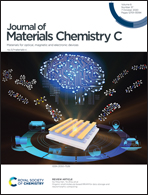The exploration of novel fluorescent copper–cysteamine nanosheets for sequential detection of Fe3+ and dopamine and fabrication of molecular logic circuits†
Abstract
Herein, newly emerged copper–cysteamine (Cu–Cy) nanosheets with red fluorescence and a good stability were explored as a new type of probe for Fe3+ and dopamine detection. The sequential detection of Fe3+ and dopamine by the use of Cu–Cy nanosheets is via a fluorescence “ON–OFF–ON” mechanism and the Cu–Cy nanosheets showed highly selective and very sensitive detection for Fe3+ with fluorescence quenching owing to the paramagnetic nature of Fe3+. Furthermore, this fluorescence quenching can be recovered upon the addition of dopamine, which can be used for the development of an “OFF–ON” fluorescence method for the detection of dopamine. The Cu–Cy provides a wider detection range (1–500 μM for Fe3+ and 1–20 μM for dopamine) than most of the other fluorescent probes reported, owing to the large two-dimensional surface area and the high chemical reactivity of the Cu–Cy. Additionally, the sensing strategy was explored by designing molecular logic gates (NOT, XNOR, and NOR) and multiple-input logic circuits in order to convert the molecular information, such as metal ion chelation and oxidation, to detectable fluorescent signals.

- This article is part of the themed collection: Quantum computing and quantum information storage: Celebrating the 2022 Nobel Prize in Physics


 Please wait while we load your content...
Please wait while we load your content...